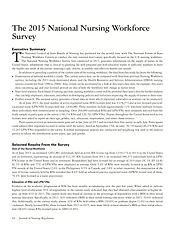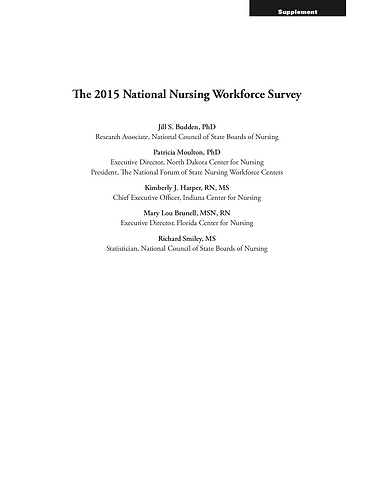
Workforce Survey
& Statistics

Client
National Council of State Boards of Nursing internal project
Duration
Ongoing; new round every 2 years
Role on Project
Principal Investigator
Skills Demonstrated
Survey vendor management
Data cleaning & management
Analyzing large data sets
Survey nonresponse bias analyses
Sampling
Introduction
For three decades the Health Resources Services Administration (HRSA) reported on the supply of nurses. This government agency was unable to continue the project, so NCSBN stepped-in to replace it. Every two years, NCSBN partners with The National Forum of State Nursing Workforce Centers to conduct the only national-level survey specifically focused on the U.S. nursing workforce. The study generates data on the supply of nurses, which is critical to plan for sufficient numbers of adequately trained nurses and ensuring a safe, diverse, accessible, and effective health care system.
Additionally, one of the four main objectives in The World Health Organization’s (WHO) new global strategy for human resources for health, Workforce 2030, is to strengthen data on the health workforce. Each country has been encouraged to develop systems that can collect and share standardized information about health worker supply, education, distribution, and qualifications. These statistics inform policy and decision making at local, national, and international levels. Data can be used to predict nurse shortages in supply-demand models, track increases in telehealth, among many other uses.
01. Research Method
Sampling
-
Approximately 260,000 nurses were randomly selected from approximately 5 million licensed nurses in the United States
-
The sample was stratified by state



Survey Design
-
31 questions
-
Online survey was custom programmed
-
Paper survey was a Scantron fillable form
Data Dictionary / Codebook
How survey responses were coded
02. Analytics
Response Rate
Approximately 34% for Registered Nurses
Nonresponse Bias Analyses
Prior to survey administration we had data on nurses sampled on a few variables
-
state
-
date of birth
-
gender
-
ethnicity
-
original licensure date
-
graduation date
Survey
Respondents
vs
Nonrespondents
The following groups of nurses were slightly over-represented
-
White/Caucasian
-
Female
-
Age 60 and older
Because of missing or incomplete data on race/ethnicity, only gender and age were used to make nonresponse weighting adjustments for RNs..
Survey
Respondents
vs
Nonrespondents
Adjusting for Bias
Weights
Main Analyses
Descriptive statistics, including means, frequencies, and cross-tabulations (with weighting variable applied)
03. Results & Insights



Executive Summary
Data collected from the study provide a snapshot of the current nursing workforce and allow for an examination of trends as compared to previous surveys. An emerging trend is that the nursing populations is changing in both ethnic/racial and gender makeup. The number of male RNs is growing slightly with a higher proportion of male nurses in the more recently licensed cohorts (13%) as versus those licensed prior to 2000 (5%). Additionally, the nursing workforce is becoming more ethnically diverse as ethnic minorities are better represented in more recently licensed RNs as compared to RNs licensed prior to 2000.
Reflecting transformations in the health care environment, the data indicated that what is considered the “work setting” for RNs is evolving. Patient care is no longer confined within the walls of a health care facility, due in part to the growing use and acceptance of technology. Nearly half of nurses reported having provided nurse services using telehealth technologies—20% across a state border and 4% across a national border. A trend that needs close monitoring given different practice rules and regulations across states and countries.
04. Pubs & Presentations
Budden, J. S. (2017, May). Collecting & Reporting Critical Nursing Workforce Supply Statistics. Presented at the International Council of Nurses 26th Quadrennial Congress, Barcelona, Spain.
Budden, J. S. (2016, October). The RN & LPN 2015 National Sample Survey Overview. Presented at the National Council of State Boards of Nursing Scientific Symposium, Chicago, IL.
Budden, J. S., Moulton, P., Harper, K. J., Brunell, M., & Smiley, R. (April 2016). The 2015 national nursing workforce survey. Journal of Nursing Regulation, 7, (supplement) S1-S92.
Budden, J. S., Moulton, P., Harper, K. J., Brunell, M. L., & Smiley, R. (2016, April). Findings from the 2015 National Nursing Workforce Study: A Collaboration between the National Council of State Boards of Nursing and The National Forum of State Nursing Workforce Centers. Presented at The National Forum of State Nursing Workforce Centers Annual Conference, Orlando, FL.
Budden, J. S. (2014, April). NCSBN & The Forum of State Nursing Workforce Centers 2013 National Workforce Survey of RNs. Poster presented at the National Council of State Boards of Nursing Scientific Symposium, Arlington, VA.
Budden, J. S. (2013, August). NCSBN & The Forum of State Nursing Workforce Centers 2013 National Workforce Survey of RNs. Poster presented at the National Council of State Boards of Nursing Annual Meeting, Providence, RI.
Budden, J. S., Zhong, E. H., Moulton, P., & Cimiotti, J. P. (2013). The National Council of State Boards of Nursing and The Forum of State Nursing Workforce Centers 2013 National Workforce Survey of Registered Nurses. Journal of Nursing Regulation, 4, (supplement) S1-S72.
Budden, J. S., Zhong, E. H., Moulton, P., & Cimiotti, J. P. (2013). Highlights of the national workforce survey of Registered Nurses. Journal of Nursing Regulation, 4, 5-14.
Budden, J. S. (2012, September). NCSBN and The Forum of State Nursing Workforce Centers National RN Workforce Study: An Overview. Presented at the National Council of State Boards of Nursing Scientific Symposium, Arlington, VA.




